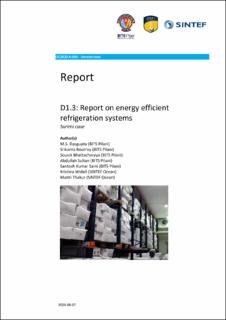ReValue project Report – D1.3: Report on energy efficient refrigeration systems - Surimi case
| dc.contributor.author | Dasgupta, Mani Sankar | |
| dc.contributor.author | Routroy, Srikanta | |
| dc.contributor.author | Bhattacharyya, Souvik | |
| dc.contributor.author | Sultan, Abdullah | |
| dc.contributor.author | Saini, Santosh Kumar | |
| dc.contributor.author | Widell, Kristina Norne | |
| dc.contributor.author | Thakur, Maitri | |
| dc.date.accessioned | 2020-08-29T16:07:33Z | |
| dc.date.available | 2020-08-29T16:07:33Z | |
| dc.date.created | 2020-08-28T15:45:48Z | |
| dc.date.issued | 2020-08-07 | |
| dc.identifier.isbn | 978-82-7174-394-9 | |
| dc.identifier.uri | https://hdl.handle.net/11250/2675575 | |
| dc.description.abstract | This report is a part of WP1 in the Revalue project and it presents the findings from research on energy-efficient and environment-friendly refrigeration system for Surimi processing and storage in warm ambient temperatures. During 2017-18, India exported about $17.6 million worth of surimi and it has good potential for further growth. The majority of surimi processing industries in India are located along the western coast and for this study, operational data from one such industry located in Mumbai has been used in this study. A surimi supply chain has substantial cooling demand at various temperatures, ranging from -40 to 8 ºC, from harvesting to the final product. Conventionally, a single NH3 refrigeration system with multiple evaporators is employed to meet the cooling demands in a processing plant, including the cold storage. However, due to several challenges faced by the surimi industry in India (Dasgupta et al, 2019), the plants operate in part-load conditions for a major part of the year and the overall efficiency is rather low. To improve energy efficiency, a smaller capacity plant is recommended and a CO2-NH3 cascaded refrigeration system (CRS) is proposed. In the cascade system, CO2 is used in low temperature circuit and NH3 in high temperature circuit, which also reduces the contamination hazard of food from NH3. Modelling and analysis of various CO2-NH3 configurations were conducted, and a CRS system having a COP of 6.2% higher than the conventional NH3 system was identified. | en_US |
| dc.language.iso | eng | en_US |
| dc.publisher | SINTEF Ocean AS | en_US |
| dc.relation.ispartofseries | SINTEF Ocean rapporter;OC2020 A-095 | |
| dc.rights | Attribution-NonCommercial-NoDerivatives 4.0 Internasjonal | * |
| dc.rights.uri | http://creativecommons.org/licenses/by-nc-nd/4.0/deed.no | * |
| dc.subject | Surim value chain | en_US |
| dc.subject | RRM | en_US |
| dc.subject | Fragmented ownership | en_US |
| dc.subject | Non-standard cold chain | en_US |
| dc.subject | Supply chain responsiveness | en_US |
| dc.title | ReValue project Report – D1.3: Report on energy efficient refrigeration systems - Surimi case | en_US |
| dc.type | Research report | en_US |
| dc.description.version | publishedVersion | en_US |
| dc.rights.holder | © SINTEF Ocean AS 2020 | en_US |
| dc.source.pagenumber | 23 | en_US |
| dc.identifier.cristin | 1825835 | |
| cristin.ispublished | true | |
| cristin.fulltext | original |
Tilhørende fil(er)
Denne innførselen finnes i følgende samling(er)
-
Publikasjoner fra CRIStin - SINTEF Ocean [1311]
-
Rapporter fra SINTEF Ocean [441]
-
SINTEF Ocean [1383]

